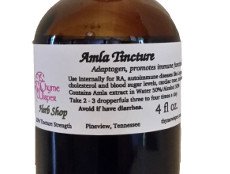In this article I want to introduce to you another amazing adaptogen. Oh. Did you miss seeing my article about adaptogens - Adaptogens for Stress and Stamina? In that article I promised I would tell you all about the different adaptogens in future articles.
The last adaptogen I wrote about was Lycium, a wonderful herb that is both an adaptogen and a superfood, also known as Goji berries. You may recall that Lycium is such a strong antioxidant that it is #5 in the list of antioxidants listed by Dr. Gregor at Nutritionfacts.org. Remember the video Better than Goji Berries that he had produced? What was #1? (I’ll wait while you go check…)

Amazing, huh? Indian Gooseberries. Well, like Lycium, Indian Gooseberries has a botanical (Latin) name – Emblica officinalis and a common name used by many herbalists – Amla. Overtime I suspect the name used by herbalists will become Emblica (some already do) in order to continue the effort to lessen the confusion of having the same common name for different plants by using a name derived from its Latin name. (For example, Eleutherococcus senticosus had a common name of Siberian Gingseng, which is misleading since it is not a gingseng, but now is Eleuthero. (Another adaptogen, so stay tuned…) And then to just make it more confusing, the Latin name was changed from Phyllanthus emblica. So older documents (and some not so old, such as Wikipedia) refer to the older Latin name.
I sell Amla as a tincture, so let’s look at the label.

OK. You knew it was going to be an adaptogen and thus it promotes immune function. But Amla is also used internally for Rheumatoid Arthritis, autoimmune diseases like lupus, cholesterol and blood sugar levels, cardiac tone, memory. My label doesn’t even mention antioxidant. There is only so much room on that label.
So is there more that Amla can do? There is an abundance of research that says YES!
In 1995 the Indian Journal of Experimental Biology published studies that demonstrated that Amla protected the liver.
In 2009 in Annals of the New York Academy of Sciences was published “Apoptosis of human primary osteoclasts treated with molecules targeting nuclear factor-kappa-B,” of which these results indicated that Amla shows promise as an alternative therapy for bone diseases.
In 2011 in European Journal of Cancer Prevention was published “Amla (Emblica officinalis), a wonder berry in the treatment and prevention of cancer.”
In 2012 in Environmental Toxicology and Pharmacology was published “Chemopreventive efficacy of Phyllanthus emblica (amla) fruit extract on 7,12-dimethylbenz(a)anthracene induced oral carcinogenesis – a dose-response study” where Amla demonstrated to be a potent cancer-preventive and protective effect against chemical carcinogens.
There is much, much more. Amla is antiviral, anti-allergenic, anti-HIV, antimutagenic, antitumor, antifungal, helps treat acute pancreatis, enhances interferon production, increases adrenal gland function, fights infection, increases lean body mass. And that’s still not all. I highly recommend the book Adaptogens in Medical Herbalism by Donald R. Yance, CN, MH, RH(AHG) to read about all the research that has been done over the years.
And remember Dr. Gregor and his video that introduced us to the antioxidant power of the Indian Gooseberry? Dr. Gregor has another video (Amla versus cancer cell growth) that details some of the findings of research on Amla.
I do want to make one final note. In my Adaptogens for Stress and Stamina article I have Amla listed as one of the “food herbs” as opposed to the “medicine herbs”. Although people in India, Southern China and other locations may have this fruit as a common food, many of us living in the West may not find it so palatable. Some say it tastes extremely bitter. Taking Amla as a tincture, I found it to be extremely astringent, literally sucking every bit of moisture out of my mouth. (Much like Rhodiola – another adaptogen to stay tuned for…) Not a pleasant sensation, but it ends fairly quickly and is worth it to me because of what it can do to help me keep my health as I age. It is suggested to get Amla in the powder form and put it in a smoothie with more palatable ingredients. If you do this, let me know what you think in the comments below.
Congratulations @thymewisper! You have completed some achievement on Steemit and have been rewarded with new badge(s) :
Click on any badge to view your own Board of Honor on SteemitBoard.
For more information about SteemitBoard, click here
If you no longer want to receive notifications, reply to this comment with the word
STOP